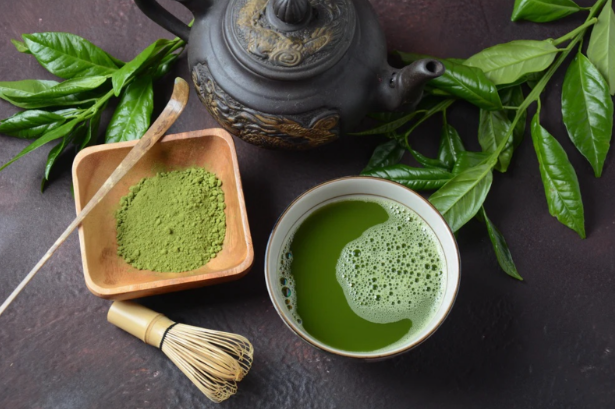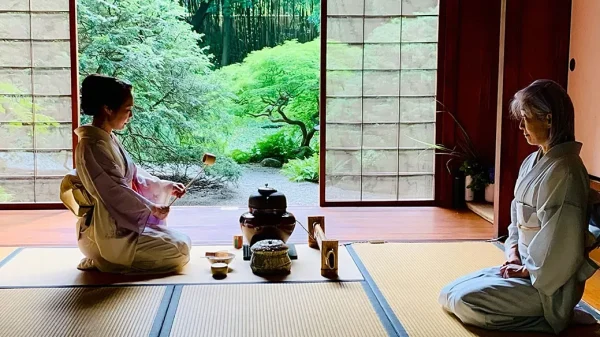
A new star has entered the drink market, matcha, and its revolution is taking over the Western world. Specifically with younger audiences, we are seeing a big shift in people’s cafe beverage preferences. This bright green tea delivers a unique bitter taste that people crave after living in a world full of processed sugar. However, is it truly accurate to label matcha as a “trend” when its roots in East Asia go back over 1,000 years?
History:
The process of cultivating tea leaves and whisking them into hot water stems from China a thousand years ago; however, matcha has gained all of its legacy as a Japanese staple. Matcha was introduced to Japan during the Muromachi period by a Zen Buddhist Monk. At that time it was primarily drunk by the samurai class, as it helped heal their mental stress from bloody warfields. Many teas, including matcha, contain a special amino acid called “L-theanine” which induces a calming state within neurotransmitters of the brain. According to a study conducted by The Department of Mental Disorder in Japan, “Stress-related symptom (i.e., depression, anxiety-trait, and sleep) scores decreased and cognitive function (i.e., verbal fluency and executive function) scores improved after four weeks of L-theanine administration.” With these special properties, warriors could feel some relaxation after days filled with bloodshed.
Now most people aren’t drinking matcha on the battlefield anymore, although health benefits are still one of the main contributors to the popularity of matcha. For example, “ceremonial grade matcha” is known as the highest quality of matcha for its strong umami flavor and maximized amino acid concentration. To achieve ceremonial grade matcha, the tea plant Camellia sinensis must be shaded and harvested for a specific amount of time. Green tea farms in Japan harvest leaves only once a year during spring. After being handpicked, leaves must be steamed to prevent oxidation, then dried and ground by a stone mill, all helping preserve the natural taste from the leaf.
*Fun Fact: Before the tea leaves are ground into Matcha powder, they are called tencha*
The traditional aspects of matcha shine in its agricultural process because even when farmers continuously try to advance the quality, they all still build off the same foundation farmers practiced in the Muromachi period.
The other major cultural aspect of matcha is Japanese tea ceremonies. Tea ceremonies are slow-paced full processes of preparing and drinking tea in a traditional tearoom with a tatami floor. They started gaining more popularity in the late 12th century when tea became more available for all social classes in Japan. The ceremonies create a social environment that also helps expand people’s knowledge about tea. It is a form of hospitality so guests can take a break from the world to relax and enjoy the tea provided by the host. Especially with the fast-paced lifestyle most Japanese cultures have in the workplace, a moment of tea can bring much-needed relaxation.

Modern Impact:
Similar to most trends these days, matcha’s prevalence in the Western world is highly accounted for with the help of social media. Brands capitalize on the bright green color and the controversial bitterness of the drink. “Does Matcha taste like grass?” is a common debate found online about the drink. However, all of this publicity just helped the consumer base of matcha expand rapidly, and soon people started getting addicted.
I interviewed the manager of the Starbucks located across from Helix to get some insight into the trends of ordering matcha. She said matcha really started gaining popularity at Starbucks last spring (2024) when the limited edition lavender matcha was first introduced. Matcha drinks have been sold at Starbucks since 2006 under the name of “Green Tea Latte” but the surprising popularity in the past years caused some rebranding. Starting from January 2025, Starbucks started offering more authentic matcha, by switching to an unsweetened powder. When Starbucks made this change, it was a great step toward preserving the cultural identity of matcha in the Western market.
The main concern that arises from the matcha revolution is preventing the gentrification of matcha. It’s strange that a drink originally for warriors is now considered the staple for soft performative men. So, how do we make sure matcha is not just an accessory, or cash grab for businesses?
First, supporting Japanese-owned cafes brings authenticity to the product and gives back to the Japanese-American community. If that is not accessible to you, there are countless matcha powders shipped from Japan that will ensure the best traditional quality. Besides the powder, a matcha whisk is the only other item needed to make matcha at home. This is a great way to save money, stay sustainable and keep matcha traditional.
The digital age has brought cultures all over the world together to share their traditions, and while it is an amazing thing, it’s important to acknowledge its history. The current trend of matcha’s popularity in America shows that it will be prevalent here for a long time, but even if another drink takes its fame, it will always have its home in Japan. So next time you reach for your iced matcha latte, remember to thank the Japanese for their heritage!